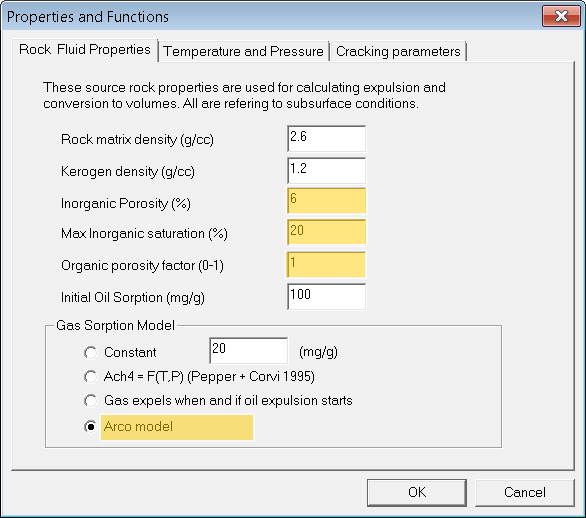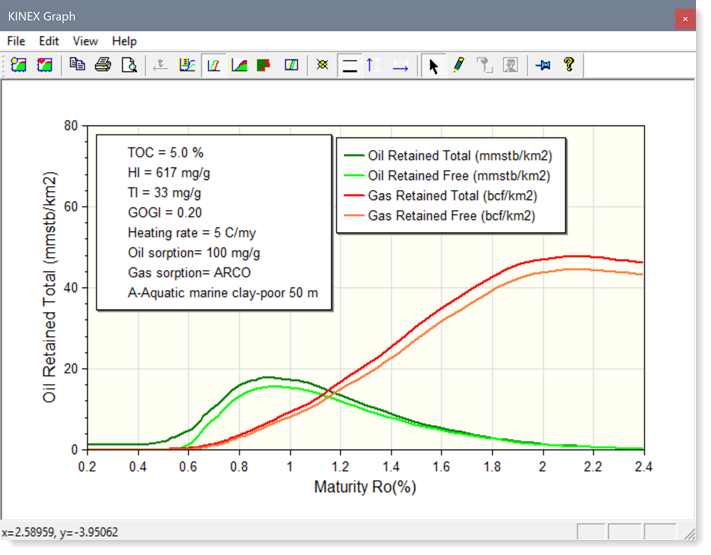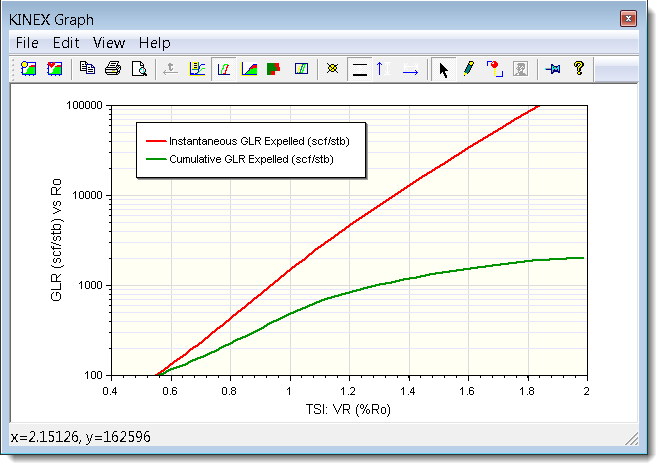| Using Kinex for Shale Evaluation |

|
| HOME | PRODUCTS | SUPPORT | UTILS | LINKS | ABOUT |
| Kinex main page | Basic concepts | Simple tutorial | Reservoir cracking | FAQ | What Is New? |
 Setup and Considerations for Shale Plays
Setup and Considerations for Shale Plays
When using Kinex to evalurate shale plays, the main consideration is the retained volumes and properties of fluids in the shale. You may take a look at some of the technical discussions on shale plays under the Trinity section. If you are using Trinity for this work, you may use Kinex to prototype the setup to make sure the numbers make sense and perhaps calibrate to some source rock (Rock Eval) or production data (API, GOR). Here is the recommended setup in Kinex under the Rocks and Fluids page.

The highlighted fields in the above are important considerations in a shale play. You may leave the others at defaults.
- Aroco expulsion model is required. It allows the additional saturation in the porosity (organic and inorganic) to be included in the mass balance. It predicts reasonable gas oil ratios in both the retained fluids are the expelled fluids, while the default BP model would not be able to. It also assumes that the adsorption of oil and gas by kerogen is a competing process, in that the presence of oil will reduce gas adsorption.
- The inorganic porosity represents the typically silt sized intergranula porosity, either isolated or interbedded with the organic rich shale intervals. These pores may be water wet and saturation is typically lower.
- The organic porosity is calculated from kerogen volume loss from generating hydrocarbons by mass balance, using the in situ density of oil and the kerogen density. You may find more details here. The factor value depends on the preservation of such porosity, which depends on clay content. A value of 1 is suitable for part of the Eagle Ford shale.
 Typical Outputs
Typical Outputs

Typically companies are interested in the resource potential of the shale, although there are more important factors if one wants to be successful in shales. The following graph displays the oil and gas in place in stp volumes. For the Eagle Ford, this model uses a 6% initial TOC, and 600 mg/gTOC HI and a net 60 meters of source rock with organo-facies A. The values of oil retained is predicted to be about 15 mmstb/km2, which is about 40 mmstb/section (sqare mile). The gas retained is about 40 bcf/km2 or about 100 bcf/section at Ro of 1.6%. You may play with the assumptions and see the sensitivity of such predictions.
One of the important factors for production and economics is the GOR of the fluid. Optimal in situ GORs for oil plays are in the 1000 to 3000 scf/bbl range, which typically happens at a Ro of 0.9 to 1.1% . The higher amount of gas would help flow rates as well as mainaining pressure. The figure below shows the instantaneous GOR which, when using ARCO expulsion model, represents the GOR of the in situ fluid, as well as the instantaneous GOR of the fluid being expelled. The expelled GOR is shown by the green curve, which is similar to what we expect in an convetional system.

To get this model to match observed GORs in production in the Eagle Ford and the Utica shale, the gas cracking kinetics had to be modified. The default gas cracking kinetics would not predict high enough GOR compared to observation. The adjustment is to decrease the activation energy for gas cracking by 10 kilo Jueles. You can do this under the cracking kinetics option. Adjust the e0 for Source rock cracking kinetics from 223.6 to 213.6.
More lately (2014), we have seen more and more evidence that the higher than expected GORs are a result of lateral migration of higher maturity fluids updip into lower maturity zones. This clearly happened in part of the Eagle Ford, and the Delaware basin.
It seems now there needs to be reservoirs, ie, higher porosity (5% - 12%) zones of various vertical scales, as well as seals (low permeability high capillary entry pressure zones) in the shale for it to have the necessary saturation.A uniform shale even with higher porosity would not build up the saturation, as increased capillary pressure would help expel the oil from the shale without the high capillary entry pressure layers to trap the hydrocarbons. Back to Kinex main page
©2003-2014, ZetaWare, Inc. All rights reserved